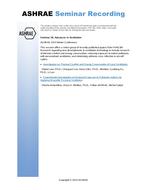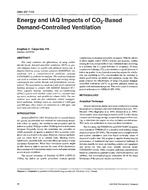Heating, ventilating, and air conditioning (HVAC) systems in buildings are designed to provide thermally comfortable conditions and tomaintain acceptable indoor air quality (IAQ). At the same time, the operating costs of HVAC systems are often a large percentage of the totalenergy consumption of buildings, which constitutes 40 % of the primary energy consumed in the U.S. As efforts are pursued to reduce buildingenergy use, some of which may include reductions in outdoor air ventilation rates, it is even more important to consider the impacts of thesemeasures on IAQ. While IAQ involves many different contaminants and sources, formaldehyde is of particular importance given the wide useurea formaldehyde resins in the production of composite wood products, including components of furniture. Also, based on the health effects ofexposure to formaldehyde, California has regulations on emissions from composite wood products, and federal regulations are expected in 2013.To better understand the IAQ and energy trade-offs of various approaches to reducing indoor formaldehyde concentrations, a series of simulationswas performed using the multizone airflow model, CONTAM, in two low-energy commercial reference buildings developed by the U.S.Department of Energy. Annual airflow and contaminant simulations were performed using assumed emission rates of formaldehyde in thesebuildings. The impact of low-emitting materials and changes in ventilation rates on formaldehyde concentrations and energy use were evaluated toinvestigate how both low-energy and IAQ goals can be met.
Citation: IAQ Conference: IAQ 2013: Environmental Health in Low Energy Buildings
Product Details
- Published:
- 2013
- Number of Pages:
- 9
- File Size:
- 1 file , 910 KB
- Product Code(s):
- D-2013IAQConf-10


